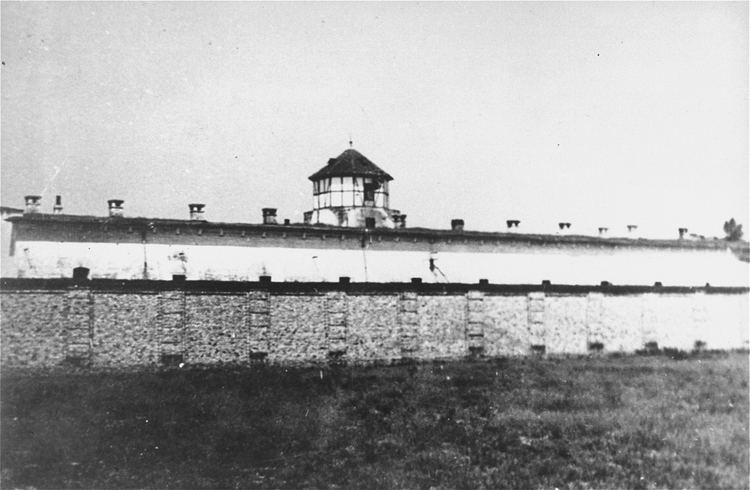Established 1941 | ||
 | ||
Location Stara Gradiška, Independent State of Croatia | ||
Stara Gradiška was one of the most notorious concentration and extermination camps in Croatia during World War II, mainly due to the crimes committed there against women and children. The camp was specially constructed for women and children of Serb, Jew, and Romani ethnicity. It was established by the Ustaše (Ustasha) regime of the Independent State of Croatia ("NDH") in 1941 at the Stara Gradiška prison near the village of Stara Gradiška. as the fifth subcamp of the Jasenovac concentration camp
Contents
According to the list of victims by name of KCL Jasenovac, the Jasenovac memorial site, which includes research as of 2007, the names and data for 12,790 victims of the camp have been established.
Systematic killing of inmates
The camp was guarded by the Croatian Ustaše, including some female troops. Inmates were killed using different means, including firearms, mallets and knives. At the "K" or "Kula" unit, Serbian and Jewish women, with weak or little children, were starved and/or tortured at the "Gagro Hotel", a cellar which Ustaša Nikola Gagro used as a place of torture. Other inmates in the Kula unit were poisoned with gas.
Gas experiments were conducted initially at veterinary stables near the "Economy" unit, where horses and then humans were poisoned using sulphur dioxide and later Zyklon B. Gassing was also tested on children in the yard, where the camp commandant, Ustaša sergeant Ante Vrban, viewed its effects. Most gassing deaths occurred in the attics of "the infamous tower", where several thousand children from the Kozara region were killed in May, and 2000 more in June 1942. Subsequently, smaller groups of 400-600 children, and a few men and women, were gassed. At this trial, Vrban stated:
Q. And what did you do with the children
A. The weaker ones we poisoned
Q. How?
A. We led them into a yard... and into it we threw gas
Q. What gas?
Witness Cijordana Friedlender (aka Jordana Fritlander) testified:
At that time fresh women and children came daily to the Camp at Stara Gradiška. About fourteen days later, Vrban [the Commandant of the Camp] ordered all children to be separated from their mothers and put into one room. Ten of us were told to carry them there in blankets. The children crawled about the room, and one child put an arm and leg through the doorway, so that the door could not be closed. Vrban shouted: 'Push it!' When I did not do that, he banged the door and crushed the child's leg. Then he took the child by its whole-leg, and banged it on the wall until it was dead. After that we continued carrying the children in. When the room was full, Vrban brought poison gas and killed them all.
According to witness Milka Zabičić, the gassing stopped due to a scheduled visit by a Red Cross delegation in 1943, which did not arrive until June 1944. Gas-vans were constructed to kill Serb and Jewish women and children who came to Stara Gradiška from the Đakovo camp in June–July 1942. A witness, Dr Dragutin Skgratić confirmed:
He (Šakić) directed his guards to pack women and children into the vans, fitted a rubber hose from the exhaust to the interior and drove around and around the camp until the passengers were dead, 'They killed at least half the group like this as soon as they arrived'.
Cruelty
Stara Gradiška became notorious for crimes committed against women and children. Examples included the torture that took place in cellar 3, the "Gagro Hotel", where inmates were starved, tortured and then strangled to death using piano wire. At Šakić's trial, witness Ivo Senjanović recalled how people were locked there without food or water: "The people were gradually dying. It was horrible to hear them cry for help." As for the conditions, witness Cadik Danon said:
At once we spread our blankets and lay down to recover our strength. Around noon they drove us out into the yard and distributed the portion of cattle turnip with water without salt or grease; everything was the same as in Jasenovac. Immediately after lunch, they thrust us into the dungeon and locked us in.
The most infamous staff included Nikola Gagro, Antun Vrban, Maja Buzdon, Jozo Stojčić and, notably, the commander, a Franciscan friar/military chaplain, Miroslav Filipović-Majstorović, who killed scores of women and children with his bare hands. The treatment of inmates was so horrific that on the night of 29 August 1942, bets were made among the prison guards as to who could liquidate the largest number of inmates. Petar Brzica, one of the guards reportedly cut the throats of 1,360 prisoners with a butcher knife. A gold watch, a silver service, a roasted suckling pig, and wine were among his rewards. The guards included females (who were sisters or wives of the male guards) known for their cruelty. The worst was Nada Luburić, sister of the first commandant of Jasenovac, Maks Luburić, and wife of Dinko Šakić.
Clearing the camp
In early April 1945, when the Partisans were fighting nearby Stara Gradiška, the Ustaše began clearing the camp, killing some of the inmates and transporting others to Lepoglava and from there to Jasenovac, where they were to be exterminated. Several survivors, like Simo (or Sime) Klaić, who stressed at Šakić's trial that Lepoglava "was horrible, as if all the evil from Stara Gradiška and Jasenovac had concentrated there", fled from the train cart in which they were to be transported to Jasenovac. Klaić later learned, as he testified in the court, that the other two carts in the transport were torched in Jasenovac. The camp was liberated in April 1945 by the Partisans.
